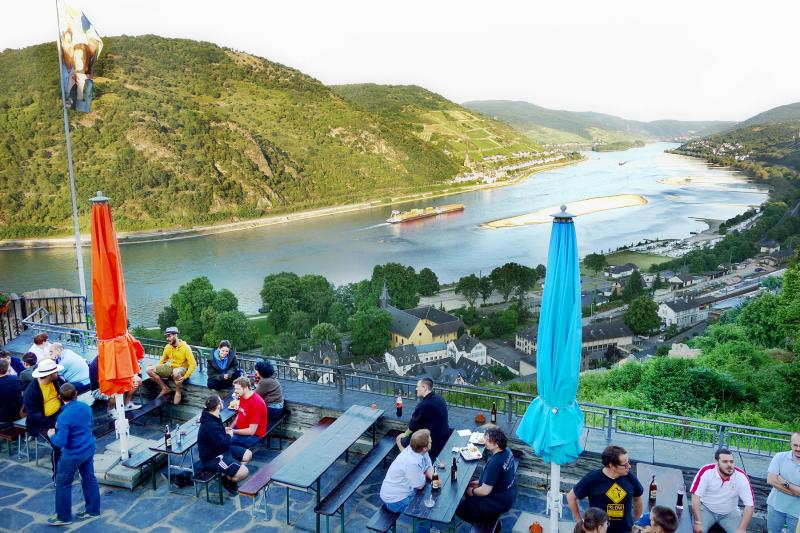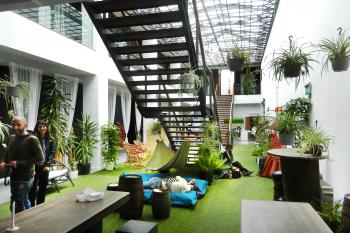Hosteling: Great for 'youths' of any age
Appears in the Online Edition, April 2018.
Many travelers wonder: "Youth hosteling ... can we still do that?" You can: Many hostels are filled with travelers well past their 20s -- and age cutoffs are generally a thing of the past. Even the International Youth Hostel Federation has removed the word "youth" from its name and is now known as Hostelling International (HI). If you're alive, you're young enough to hostel.
Of course, hosteling originated as a way for young backpackers to sleep safely and comfortably without the expense of a hotel. It's still fundamentally that. But as Europe has grown more affluent, hostels have become cushier -- more expensive, but with more privacy and perks. While the cheapest beds are still in big dorms where you may have 10 or more roommates, these days hostels offer smaller rooms (even singles and doubles) and a much better shower-to-bed ratio.
Hosteling is great for solo travelers on a tight budget: While a single hotel room costs nearly the same as a double, in a hostel you pay by the bed. Hostels come with an instant circle of potential new friends from around the world, making it easy to find dinner or sightseeing companions. They're also great for families who want to share one big room and do their own cooking -- enjoying meals for the price of groceries.
Many hostels also offer a simple breakfast, serve cheap meals (often in family-style settings), and provide use of a fully equipped kitchen. Some of the bigger, old-school hostels serve cheap cafeteria-style dinners, while many newer ones have an affordable restaurant on site. Travelers can also commune in common areas -- whether a spacious lounge, or a cozy den stocked with board games and a lending library.
European hostels that belong to the venerable Hostelling International organization are generally big, institutional, clean and well organized, while independently run hostels tend to be more easygoing and colorful (or chaotic and ramshackle, depending on the place). While HI hostels generally segregate travelers into same-sex dorms, independent hostels often offer co-ed dorms as well as women-only dorms.
I've hosteled mostly in northern Europe, where places are more comfortable and the savings over hotels more exciting. This is particularly true in the Nordic countries, which have some of Europe's finest hostels. In any Nordic city, you'll find clean, modern, centrally located hostels with private rooms and bathrooms, from the huge, harborside, 16-story Danhostel Copenhagen City to Stockholm's Langholmen Hostel, a former prison in a lovely park on a small island, with converted jail cells as rooms.
You'll find some unforgettable options. The Af Chapman Hostel in Stockholm lets you sleep in a restored ship cabin on a permanently moored 100-year-old schooner. Helsinki's Eurohostel comes with a free morning sauna. And Reykjavík's Galaxy Pod Hostel oers a futuristic feel: Guests get their own space-age sleeping capsule, which offers a little privacy and space to lock up valuables.
While I generally don't hostel in southern Europe (where they're less common and budget hotels are easier to find), I make an exception in Lisbon, which is famous for its boutique hostels. Big, convivial and professional, these stylish "design hostels" come with an artistic flair and are a Lisbon specialty. Besides the usual dorm beds, most have plenty of double rooms and offer nice extras like bike rentals and movie nights.
My favorite -- Lisbon Destination Hostel -- is located upstairs in the Rossio train station, next to the platforms. The rooms are stylish and peaceful, and the Astroturfed lounge -- with beanbag chairs and hammocks -- sprawls beneath an Industrial Age glass canopy. Equally trendy are the Living Lounge and Lisbon Lounge hostels: Owned by a group of Portuguese artists, these feature distinctively decorated rooms. It's fun to view each room online and pick one to suit your style.
Some of the best hostels are in remote settings. For instance, St. Briavels Castle Youth Hostel, in a quiet village on the Wales/Englandborder, lets you sleep in an 800-year-old Norman castle. Chalet Martin in Gryon, Switzerland, is a rustic retreat with a few characteristic private rooms (including a tent with a bed) and stunning mountain views. At the Eplet Bed & Apple hostel, in Solvorn, Norway, you'll enjoy a country home with friendly hosts, a raspberry-and-apple farm and breathtaking fjord views.
One of my best travel memories is of hosteling along the Rhine Riverin Germany, in one of Europe's great youth hostels: Stahleck Castle. Imagine the thrill of spending just $40 a night for a bed in a 12th-century castle on a hilltop -- 350 steps above the town of Bacharach -- and ending your day with a drink on your own Rhine-view balcony.
Travelers of all ages should consider hosteling. Even though you may sacrifice some luxury and privacy, you're likely to collect colorful new friends, insights and experiences.
(Rick Steves (www.ricksteves.com) writes European travel guidebooks and hosts travel shows on public television and public radio. Email him at rick@ricksteves.com and follow his blog on Facebook.)


